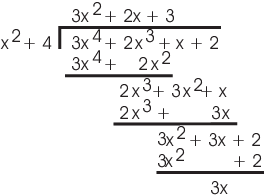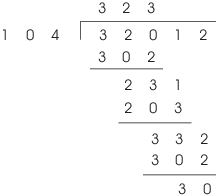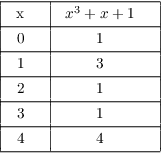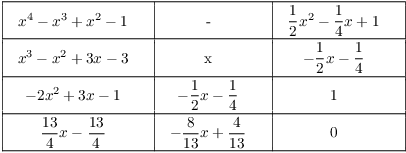If R is a ring, the ring of polynomials in x with
coefficients in R is denoted ![]() . It consists of all
formal sums
. It consists of all
formal sums
![]()
Here ![]() for all but finitely many values of i.
for all but finitely many values of i.
If the idea of "formal sums" worries you, replace a formal sum with the infinite vector whose components are the coefficients of the sum:
![]()
All of the operations which I'll define using formal sums can be defined using vectors. But it's traditional to represent polynomials as formal sums, so this is what I'll do.
A nonzero polynomial ![]() has degree n if
has degree n if ![]() and
and ![]() , and n is the largest integer
with this property. The zero polynomial is defined by convention to
have degree
, and n is the largest integer
with this property. The zero polynomial is defined by convention to
have degree ![]() . (This is necessary in order to make the
degree formulas work out.) Alternatively, you can say that the degree
of the zero polynomial is undefined; in that case, you will need to
make minor changes to some of the results below.
. (This is necessary in order to make the
degree formulas work out.) Alternatively, you can say that the degree
of the zero polynomial is undefined; in that case, you will need to
make minor changes to some of the results below.
Polynomials are added componentwise, and multiplied using the "convolution" formula:
![]()

These formulas say that you compute sums and products as usual.
Example. ( Polynomial arithmetic) (a) Compute
![]()
(b) Compute
![]()
(a)
![]()
![]()
(b)
![]()
![]()
Let R be an integral domain. Then If ![]() , write
, write ![]() to denote the degree of f.
It's easy to show that the degree function satisfies the following
properties:
to denote the degree of f.
It's easy to show that the degree function satisfies the following
properties:
![]()
![]()
The verifications amount to writing out the formal sums, with a
little attention paid to the case of the zero polynomial. These
formulas do work if either f or g is equal to the zero
polynomial, provided that ![]() is understood to
behave in the obvious ways (e.g.
is understood to
behave in the obvious ways (e.g. ![]() for
any
for
any ![]() ).
).
Example. ( Degrees of
polynomials) (a) Give examples of polynomials ![]() such that
such that ![]()
(b) Give examples of polynomials ![]() such that
such that ![]() .
.
(a)
![]()
This shows that equality might not hold in ![]() .
.![]()
(b)
![]()
Proposition. Let F be a field, and let ![]() be the polynomial ring in one variable over F. The
units in
be the polynomial ring in one variable over F. The
units in ![]() are exactly the nonzero elements of F.
are exactly the nonzero elements of F.
Proof. It's clear that the nonzero elements of
F are invertible in ![]() , since they're already invertible
in F. Conversely, suppose that
, since they're already invertible
in F. Conversely, suppose that ![]() is
invertible, so
is
invertible, so ![]() for some
for some ![]() . Then
. Then ![]() , which
is impossible unless f and g both have degree 0. In particular, f is
a nonzero constant, i.e. an element of F.
, which
is impossible unless f and g both have degree 0. In particular, f is
a nonzero constant, i.e. an element of F.![]()
Theorem. ( Division
Algorithm) Let F be a field, and let ![]() . Suppose that
. Suppose that ![]() . There are unique
polynomials
. There are unique
polynomials ![]() such that
such that
![]()
Proof. The idea is to imitate the proof of the
Division Algorithm for ![]() .
.
Let
![]()
The set ![]() is a subset of the
nonnegative integers, and therefore must contain a smallest element
by well-ordering. Let
is a subset of the
nonnegative integers, and therefore must contain a smallest element
by well-ordering. Let ![]() be an element in S of
smallest degree, and write
be an element in S of
smallest degree, and write
![]()
I need to show that ![]() .
.
If ![]() , then since
, then since ![]() , I have
, I have ![]() .
.
Suppose then that ![]() . Assume toward a
contradiction that
. Assume toward a
contradiction that ![]() . Write
. Write
![]()
![]()
Assume ![]() , and
, and ![]() .
.
Consider the polynomial
![]()
Its degree is less than n, since the n-th degree terms cancel out.
However,
![]()
The latter is an element of S.
I've found an element of S of smaller degree than ![]() , which is a contradiction. It follows that
, which is a contradiction. It follows that ![]() .
.
Finally, to prove uniqueness, suppose
![]()
Rearranging the equation, I get
![]()
Then
![]()
But ![]() . The equation can
only hold if
. The equation can
only hold if
![]()
This means
![]()
Hence, ![]() and
and ![]() .
.![]()
Example. ( Polynomial
division) Divide ![]() by
by ![]() in
in ![]() .
.
Remember as you follow the division that ![]() ,
, ![]() , and
, and ![]() --- I'm doing arithmetic mod 5.
--- I'm doing arithmetic mod 5.

If you prefer, you can do long division without writing the powers of x --- i.e. just writing down the coefficients. Here's how it looks:

Either way, the quotient is ![]() and the remainder
is
and the remainder
is ![]() :
:
![]()
Definition. Let R be a commutative ring and
let ![]() . An element
. An element ![]() is a root of
is a root of ![]() if
if ![]() .
.
Note that polynomials are actually formal sums, not functions. However, it is obvious how to plug a number into a polynomial. Specifically, let
![]()
For ![]() , define
, define
![]()
Observe that a polynomial can be nonzero as a
polynomial even if it equals 0 for every input! For example,
take ![]() is a nonzero
polynomial. However, plugging in the two elements of the coefficient
ring
is a nonzero
polynomial. However, plugging in the two elements of the coefficient
ring ![]() gives
gives
![]()
Theorem. Let F be a field, and let ![]() , where
, where ![]() .
.
(a) ( The Root Theorem) c is a root of ![]() in F if and only if
in F if and only if ![]() .
.
(b) ![]() has at most n roots in F.
has at most n roots in F.
Proof. (a) Suppose ![]() . Write
. Write
![]()
Then ![]() or
or ![]() .
.
In the first case, r is a nonzero constant. However, this implies that
![]()
This contradiction shows that ![]() , and
, and ![]() .
.
Conversely, if ![]() is a factor of
is a factor of ![]() , then
, then ![]() for some
for some ![]() . Hence,
. Hence,
![]()
Hence, c is a root of f.
(b) If ![]() are the distinct roots of f in F,
then
are the distinct roots of f in F,
then
![]()
Taking degrees on both sides gives ![]() .
.![]()
Example. ( Applying the Root
Theorem) In ![]() , show:
, show:
(a) ![]() is a factor of
is a factor of ![]() .
.
(b) ![]() is a factor of
is a factor of ![]() for any
for any ![]() .
.
(a) If ![]() , then
, then ![]() . Hence, 1 is a root of
. Hence, 1 is a root of ![]() , and by the Root Theorem
, and by the Root Theorem ![]() is a factor of
is a factor of ![]() .
.![]()
(b) If ![]() , then
, then ![]() . Hence, 1 is a root of
. Hence, 1 is a root of ![]() , so
, so ![]() is a factor of
is a factor of ![]() by the Root Theorem.
by the Root Theorem.![]()
Example. ( Applying the Root
Theorem) Prove that ![]() is
divisible by
is
divisible by ![]() in
in ![]() .
.
Plugging in ![]() into
into ![]() gives
gives
![]()
Since ![]() is a root,
is a root, ![]() is a factor by the Root Theorem.
is a factor by the Root Theorem.![]()
Remark. If the ground ring isn't a field, it's
possible for a polynomial to have more roots than its degree. For
example, the quadratic polynomial ![]() has roots
has roots ![]() ,
, ![]() ,
, ![]() ,
, ![]() . The previous result does not apply, because
. The previous result does not apply, because ![]() is not a field.
is not a field.
Corollary. ( The Remainder
Theorem) Let F be a field, ![]() , and let
, and let ![]() . When
. When ![]() is divided by
is divided by ![]() , the remainder is
, the remainder is ![]() .
.
Proof. Divide ![]() by
by ![]() :
:
![]()
Since ![]() , it follows that
, it follows that ![]() is a constant. But
is a constant. But
![]()
Therefore, the constant value of ![]() is
is ![]() .
.![]()
Example. ( Applying the
Remainder Theorem) Suppose ![]() leaves a
remainder of 5 when divided by
leaves a
remainder of 5 when divided by ![]() and a remainder of
-1 when divided by
and a remainder of
-1 when divided by ![]() . What is the remainder when
. What is the remainder when ![]() is divided by
is divided by ![]() ?
?
By the Remainder Theorem,
![]()
Now divide ![]() by
by ![]() . The
remainder
. The
remainder ![]() has degree less than
has degree less than ![]() , so
, so ![]() for some
for some ![]() :
:
![]()
Then
![]()
Solving the two equations for a and b, I get ![]() and
and ![]() . Thus, the remainder is
. Thus, the remainder is ![]() .
.![]()
Definition. Let R be an integral domain.
(a) If ![]() , then x divides y
if
, then x divides y
if ![]() for some
for some ![]() . Write
. Write ![]() to mean that x divides y.
to mean that x divides y.
(b) x and y are associates if ![]() , where u is a unit.
, where u is a unit.
(Recall that a unit in a ring is an element with a multiplicative inverse.)
(c) An element ![]() is
irreducible if
is
irreducible if ![]() , x is not a unit, and if
, x is not a unit, and if ![]() implies either y is a unit or z is a unit.
implies either y is a unit or z is a unit.
(d) An element ![]() is prime if
is prime if
![]() , x is not a unit, and
, x is not a unit, and ![]() implies
implies ![]() or
or ![]() .
.
Proposition. A nonzero nonconstant polynomial
![]() is irreducible if and only if
is irreducible if and only if ![]() implies that either g or h is a constant.
implies that either g or h is a constant.
Proof. Suppose ![]() is irreducible and
is irreducible and ![]() . Then
one of
. Then
one of ![]() ,
, ![]() is a unit. But we
showed earlier that the units in
is a unit. But we
showed earlier that the units in ![]() are the constant
polynomials.
are the constant
polynomials.
Suppose that ![]() is a nonzero nonconstant polynomial, and
is a nonzero nonconstant polynomial, and
![]() implies that either g or h is a constant.
implies that either g or h is a constant.
Since f is nonconstant, it's not a unit. Note that if ![]() , then
, then ![]() , since
, since ![]() .
.
Therefore, the condition that ![]() implies
that either g or h is a constant means that
implies
that either g or h is a constant means that ![]() implies that either
implies that either ![]() or
or ![]() is a unit --- again, since the
nonzero constant polynomials are the units in
is a unit --- again, since the
nonzero constant polynomials are the units in ![]() . This is what it means for f to be irreducible.
. This is what it means for f to be irreducible.![]()
Example. Show that ![]() is irreducible in
is irreducible in ![]() but not in
but not in ![]() .
.
![]() has no real roots, so by the Root Theorem it has no
linear factors. Hence, it's irreducibile in
has no real roots, so by the Root Theorem it has no
linear factors. Hence, it's irreducibile in ![]() .
.
However, ![]() in
in ![]() .
.![]()
Corollary. Let F be a field. A polynomial of
degree 2 or 3 in ![]() is irreducible if and only if it
has no roots in F.
is irreducible if and only if it
has no roots in F.
Proof. Suppose ![]() has degree 2 or 3.
has degree 2 or 3.
If f is not irreducible, then ![]() , where
neither g nor h is constant. Now
, where
neither g nor h is constant. Now ![]() and
and ![]() , and
, and
![]()
This is only possible if at least one of g or h has degree 1. This
means that at least one of g or h is a linear factor ![]() , and must therefore have a root in F. Since
, and must therefore have a root in F. Since ![]() , it follows that f has a root in F as
well.
, it follows that f has a root in F as
well.
Conversely, if f has a root c in F, then ![]() is a factor of f by the Root Theorem. Since f has
degree 2 or 3,
is a factor of f by the Root Theorem. Since f has
degree 2 or 3, ![]() is a proper factor, and f is not
irreducible.
is a proper factor, and f is not
irreducible.![]()
Remark. The result is false for polynomials of
degree 4 or higher. For example, ![]() has no roots
in
has no roots
in ![]() , but it is not irreducible over
, but it is not irreducible over ![]() .
.
Example. ( Checking for
irreducibility of a quadratic or cubic) Show that ![]() is irreducible.
is irreducible.
Since this is a cubic polynomial, I only need to see whether it has any roots.

Since ![]() has no roots in
has no roots in ![]() , it's irreducible.
, it's irreducible.![]()
Proposition. In an integral domain, primes are irreducible.
Proof. Let x be prime. I must show x is
irreducible. Suppose ![]() . I must show either y or z is
a unit.
. I must show either y or z is
a unit.
![]() , so obviously
, so obviously ![]() . Thus,
. Thus, ![]() or
or ![]() . Without loss of generality,
suppose
. Without loss of generality,
suppose ![]() .
.
Write ![]() . Then
. Then ![]() , and
since
, and
since ![]() (primes are nonzero) and we're in a domain,
(primes are nonzero) and we're in a domain,
![]() . Therefore, z is a unit, and x is irreducible.
. Therefore, z is a unit, and x is irreducible.![]()
Definition. Let R be an integral domain, and
let ![]() .
. ![]() is a greatest common divisor of x and y if:
is a greatest common divisor of x and y if:
(a) ![]() and
and ![]() .
.
(b) If ![]() and
and ![]() , then
, then ![]() .
.
The definition says "a" greatest common divisor, rather than "the" greatest common divisor, because greatest common divisors are only unique up to multiplication by units.
The definition above is the right one if you're dealing with an arbitrary integral domain. However, if your ring is a polynomial ring, it's nice to single out a "special" greatest common divisor and call it the greatest common divisor.
Definition. A monic polynomial is a polynomial whose leading coefficient is 1.
For example, here are some monic polynomials over ![]() :
:
![]()
Definition. Let F be a field, let ![]() be the ring of polynomials with coefficients in F,
and let
be the ring of polynomials with coefficients in F,
and let ![]() , where f and g are not both zero.
The greatest common divisor of f and
g is the monic polynomial which is a greatest common divisor of f and
g (in the integral domain sense).
, where f and g are not both zero.
The greatest common divisor of f and
g is the monic polynomial which is a greatest common divisor of f and
g (in the integral domain sense).
Example. ( Polynomial
greatest common divisors) Find the greatest common divisor of
![]() and
and ![]() in
in ![]() .
.
![]() is a greatest common divisor of
is a greatest common divisor of ![]() and
and ![]() :
:
![]()
![]()
Notice that any nonzero constant multiple of ![]() is also a greatest common divisor of
is also a greatest common divisor of ![]() and
and ![]() (in the integral domain
sense): For example,
(in the integral domain
sense): For example, ![]() works. This makes sense, because the units in
works. This makes sense, because the units in ![]() are the nonzero elements of
are the nonzero elements of ![]() . But by convention, I'll refer to
. But by convention, I'll refer to ![]() --- the monic greatest common divisor --- as
the greatest common divisor of
--- the monic greatest common divisor --- as
the greatest common divisor of ![]() and
and ![]() .
.![]()
The preceding definition assumes there is a greatest common
divisor for two polynomials in ![]() . In fact, the
greatest common divisor of two polynomials exists --- provided that
both polynomials aren't 0 --- and the proof is essentially the same
as the proof for greatest common divisors of integers.
. In fact, the
greatest common divisor of two polynomials exists --- provided that
both polynomials aren't 0 --- and the proof is essentially the same
as the proof for greatest common divisors of integers.
In both cases, the idea is to use the Division Algorithm repeatedly until you obtain a remainder of 0. This must happen in the polynomial case, because the Division Algorithm for polynomials specifies that the remainder has strictly smaller degree than the divisor.
Just as in the case of the integers, each use of the Division Algorithm does not change the greatest common divisor. So the last pair has the same greatest common divisor as the first pair --- but the last pair consists of 0 and the last nonzero remainder, so the last nonzero remainder is the greatest common divisor.
This process is called the Euclidean algorithm, just as in the case of the integers.
Let h and ![]() be two greatest common divisors of f and g.
By definition,
be two greatest common divisors of f and g.
By definition, ![]() and
and ![]() . From this, it follows that h and
. From this, it follows that h and ![]() have the same degree, and are constant multiples of
one another. If h and
have the same degree, and are constant multiples of
one another. If h and ![]() are both monic --- i.e.
both have leading coefficient 1 --- this is only possible if they're
equal. So there is a unique monic greatest common divisor
for any two polynomials.
are both monic --- i.e.
both have leading coefficient 1 --- this is only possible if they're
equal. So there is a unique monic greatest common divisor
for any two polynomials.
Finally, the same proofs that I gave for the integers show that you can write the greatest common divisor of two polynomials as a linear combination of the two polynomials. You can use the Extended Euclidean Algorithm that you learned for integers to find a linear combination. To summarize:
Theorem. Let F be a field, ![]() , f and g not both 0.
, f and g not both 0.
(a) f and g have a unique (monic) greatest common divisor.
(b) There exist polynomials ![]() such that
such that
![]()
Example. ( Applying the
Extended Euclidean Algorithm) Find the greatest common divisor
of ![]() and
and ![]() in
in ![]() and express the
greatest common divisor as a linear combination of
and express the
greatest common divisor as a linear combination of ![]() and
and ![]() with coefficients in
with coefficients in ![]() .
.

The greatest common divisor is ![]() . The greatest common divisor is only determined up
to multiplying by a unit, so multiplying by
. The greatest common divisor is only determined up
to multiplying by a unit, so multiplying by ![]() gives the monic greatest common divisor
gives the monic greatest common divisor
![]() .
.
You can check that
![]()
Example. ( Applying the
Extended Euclidean Algorithm) Find the greatest common divisor
of ![]() and
and ![]() in
in ![]() and express the greatest common divisor as
a linear combination of
and express the greatest common divisor as
a linear combination of ![]() and
and ![]() with coefficients in
with coefficients in ![]() .
.

The greatest common divisor is ![]() , and
, and
![]()
The greatest common divisor is only determined up to multiplying by a unit. So, for example, I can multiply the last equation by 2 to get
![]()
Copyright 2018 by Bruce Ikenaga